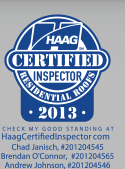
To get the most years out of your roof, we always emphasize to our customers the importance of having roof inspections done twice a year as a proactive approach to fixing any roof damage before it turns into major roof repairs or a complete roof replacement. An important part of those roof inspections is a chimney inspection. That’s because a chimney in disrepair can adversely impact the health of your roof.
As a HAAG certified roofing inspector, the Roofing Annex team is specially trained to look for certain things on a chimney that could lead to serious roof problems. There are three main areas of your chimney that we focus on to keep your roof healthy and at peak performance.
1. Basic Condition
We perform an overall inspection to examine the structural integrity of the chimney and the condition of its building materials. Often times, age or weather, such as strong winds, hail, or frost, can damage the structure of a chimney, both inside and out. During our inspection, we look for holes, missing pieces, cracks, or crumbling roof cement or caulking. We also inspect for any rust, missing or unsealed parts, such as the chimney cap, and the condition of chimney connections.
For chimneys with exterior cedar or wood siding, we look specifically for knots in the wood that may have fallen out or become loose and splits in the chimney’s cedar siding. These two conditions can cause water runoff to flow behind the chimney’s flashing and lead to roof rot and interior leaks.
2. Flashing
Chimney flashing is a weatherproof material, usually made of sheet metal, that is installed around the bottom of the chimney at the junction where it meets the roof. Flashing is extremely important for deflecting water away from joints or seams so it does not leak into the home. One of the most common areas for roof leaks is the point where the chimney meets the roof.
Different types of flashing are used around a chimney. Base flashing is used at the vertical or upturned juncture of the roof with the chimney. Step flashing is typically installed around the edges of the chimney stack. There is also counter flashing, where two parallel pieces of flashing are used to seal junctures or overlaps of replaced base flashing.
Chimney flashing needs to be replaced when it is missing, cracked, torn, damaged, rusted, or when shingles are being replaced. Flashing problems left unaddressed can lead to a premature roof replacement.
3. The Chimney Flue
The main role of chimney flues is to prevent smoke or gas when a fireplace is in operation from backing up into the home. When inspecting your chimney flue, we look for cracks and check that the flue is properly aligned.
Peace of Mind
No matter what type of chimney you have, it needs maintenance from time to time. The most important reason for having a chimney inspection, whether done independently or as part of your biannual roof inspection, is to ensure that all chimney components are in good working order and tightly sealed. For a comprehensive and certified roofing inspection that includes your chimney, contact the Roofing Annex and we will promptly schedule an inspection visit.







